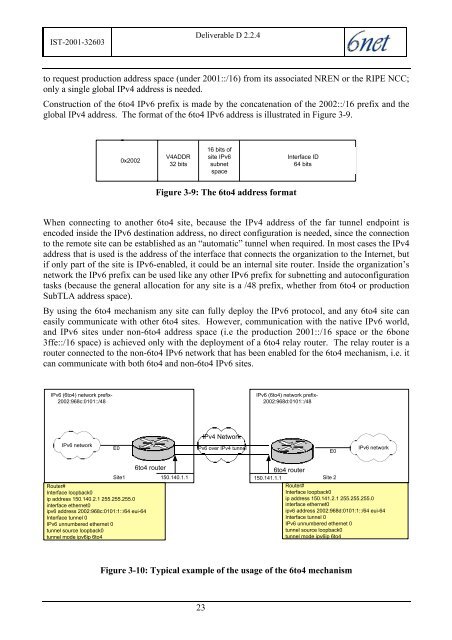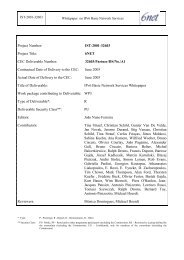D2.2.4: Final IPv4 to IPv6 Transition Cookbook for ... - 6NET
D2.2.4: Final IPv4 to IPv6 Transition Cookbook for ... - 6NET
D2.2.4: Final IPv4 to IPv6 Transition Cookbook for ... - 6NET
Create successful ePaper yourself
Turn your PDF publications into a flip-book with our unique Google optimized e-Paper software.
IST-2001-32603Deliverable D 2.2.4<strong>to</strong> request production address space (under 2001::/16) from its associated NREN or the RIPE NCC;only a single global <strong>IPv4</strong> address is needed.Construction of the 6<strong>to</strong>4 <strong>IPv6</strong> prefix is made by the concatenation of the 2002::/16 prefix and theglobal <strong>IPv4</strong> address. The <strong>for</strong>mat of the 6<strong>to</strong>4 <strong>IPv6</strong> address is illustrated in Figure 3-9.0x2002V4ADDR32 bits16 bits ofsite <strong>IPv6</strong>subnetspaceInterface ID64 bitsFigure 3-9: The 6<strong>to</strong>4 address <strong>for</strong>matWhen connecting <strong>to</strong> another 6<strong>to</strong>4 site, because the <strong>IPv4</strong> address of the far tunnel endpoint isencoded inside the <strong>IPv6</strong> destination address, no direct configuration is needed, since the connection<strong>to</strong> the remote site can be established as an “au<strong>to</strong>matic” tunnel when required. In most cases the <strong>IPv4</strong>address that is used is the address of the interface that connects the organization <strong>to</strong> the Internet, butif only part of the site is <strong>IPv6</strong>-enabled, it could be an internal site router. Inside the organization’snetwork the <strong>IPv6</strong> prefix can be used like any other <strong>IPv6</strong> prefix <strong>for</strong> subnetting and au<strong>to</strong>configurationtasks (because the general allocation <strong>for</strong> any site is a /48 prefix, whether from 6<strong>to</strong>4 or productionSubTLA address space).By using the 6<strong>to</strong>4 mechanism any site can fully deploy the <strong>IPv6</strong> pro<strong>to</strong>col, and any 6<strong>to</strong>4 site caneasily communicate with other 6<strong>to</strong>4 sites. However, communication with the native <strong>IPv6</strong> world,and <strong>IPv6</strong> sites under non-6<strong>to</strong>4 address space (i.e the production 2001::/16 space or the 6bone3ffe::/16 space) is achieved only with the deployment of a 6<strong>to</strong>4 relay router. The relay router is arouter connected <strong>to</strong> the non-6<strong>to</strong>4 <strong>IPv6</strong> network that has been enabled <strong>for</strong> the 6<strong>to</strong>4 mechanism, i.e. itcan communicate with both 6<strong>to</strong>4 and non-6<strong>to</strong>4 <strong>IPv6</strong> sites.<strong>IPv6</strong> (6<strong>to</strong>4) network prefix-2002:968c:0101::/48<strong>IPv6</strong> (6<strong>to</strong>4) network prefix-2002:968d:0101::/48<strong>IPv6</strong> networkE0<strong>IPv4</strong> Network<strong>IPv6</strong> over <strong>IPv4</strong> tunnelE0<strong>IPv6</strong> networkRouter#Interface loopback0ip address 150.140.2.1 255.255.255.0interface ethernet0ipv6 address 2002:968c:0101:1::/64 eui-64Interface tunnel 0<strong>IPv6</strong> unnumbered ethernet 0tunnel source loopback0tunnel mode ipv6ip 6<strong>to</strong>46<strong>to</strong>4 router6<strong>to</strong>4 routerSite1 150.140.1.1 150.141.1.1Site 2Router#Interface loopback0ip address 150.141.2.1 255.255.255.0interface ethernet0ipv6 address 2002:968d:0101:1::/64 eui-64Interface tunnel 0<strong>IPv6</strong> unnumbered ethernet 0tunnel source loopback0tunnel mode ipv6ip 6<strong>to</strong>4Figure 3-10: Typical example of the usage of the 6<strong>to</strong>4 mechanism23






